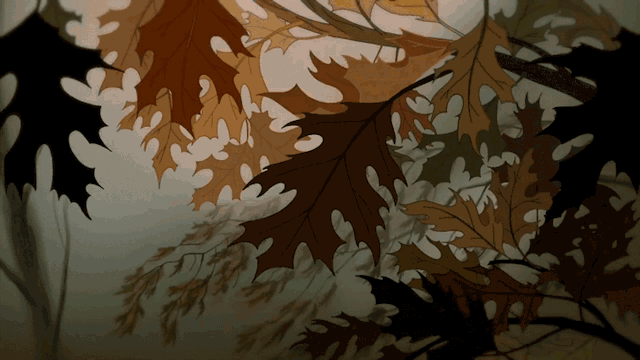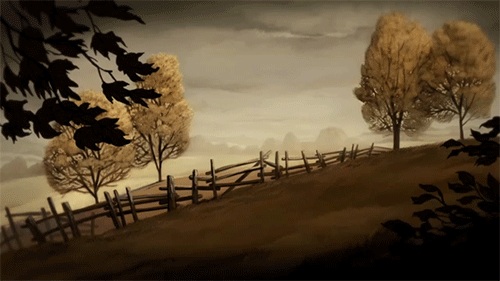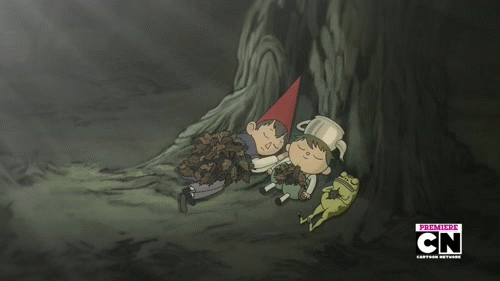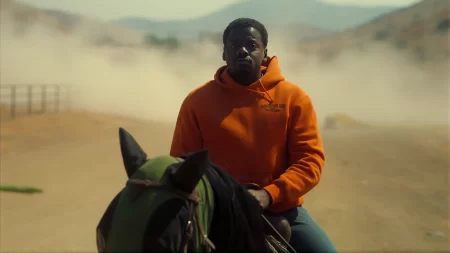Travel Over the Garden Wall
I would like to introduce the uninitiated to Over the Garden Wall, a cartoon miniseries for all ages that is best watched huddled comfortably around a screen, wrapped in a cozy blanket, as the slow-roasted warm tones of the changing leaves outside are lost in the darkness of night and stolen away from their trees by the cool, crisp autumn air.
Into the Unknown
Over the Garden Wall is Cartoon Network’s first cartoon miniseries. It consists of ten episodes, each 11 minutes long, that together tell the story of two stepbrothers lost in an unfamiliar forest trying to return home. It originally aired in early November 2014 in two-episode installments over the course of five days. The series went on to win Best Animated Feature at the Ottawa International Film Festival. It also won two Primetime Creative Arts Emmys: one for Outstanding Animated Program and another for Outstanding Individual Achievement in Animation, awarded to art director Nick Cross.
Miniseries creator Patrick McHale, former writer and storyboard artist for both The Marvelous Misadventures of Flapjack and Adventure Time, based Over the Garden Wall on his animated short Tome of the Unknown: Harvest Melody.
The short is available on Cartoon Network’s YouTube channel for free if you want an idea of the main characters, art, and music. But Tome of the Unknown doesn’t so much showcase the brilliant, tenebrous mood of the miniseries’ story, nor the way each episode lends itself to the next and transforms into something greater than the sum of its parts by the finale.

Led Through the Mists
I’m finding it very difficult to describe Over the Garden Wall in a useful, accurate way. I don’t want to spoil much about it for those who haven’t seen it yet and would like to go into it more or less blind. But, I would also like to really sell you on this wonderful, complex, yet approachable piece of art. It’s easy to watch, and very silly. The individual episodes feel like better-than-average cartoon fare, at the end of the day. Put together, however, the miniseries has just the right amount of magic in its tone and narrative to create something your brain can really chew on and savor every time you watch it.
On the whole, I’m inclined to pitch Over the Garden Wall as a classic, contemporary, and altogether exceptional fairy tale.
Over the Garden Wall tells a tale that is equal parts humorous and haunting. The creepy/funny story unfolds and comes together in such a pleasant, smooth, and effortless way, all while the miniseries showers you with stunning artwork, beautiful music, contemporary cartoon animation, and nervous laughs.
If that’s all I need to write in order to convince you to go give this puppy a whirl, by all means stop reading here and put this sucker in your calendar to watch along with some hot apple cider and candy corn. If not, the rest of this article will — in classic, verbose Anna fashion — go into more detail about what makes this miniseries worth watching.
Remember, my pitch is “a classic, contemporary fairy tale, perfect for watching in the fall with a very complex underlying tone,” and the rest of this article is basically a big essay I wrote to help prove it/sell it to you based on this premise. Okay? Okay. Buckle up. I cover a lot of material, but I hope it will be enjoyable. (In case you were wondering, the headers of this piece are the title and lyrics of the opening and closing song of the series.)
By the Milk Light of Moon
Over the Garden Wall exudes a faded nostalgia not necessarily your own. This feeling achieves a sense of realness, or perhaps vividness, which engulfs you enough to believe that it is yours, if only for the duration of the miniseries. It is this mood that reminds me of classic fairy tales and fables. A sort of déjà vu washes over you when you engage with these storybook tales. Not only do you get an inkling that this has all happened before, but there is also an implicit feeling that it will all happen again. Over the Garden Wall cultivates this familiar, storybook-like quality through many of its components — particularly through setting. And the miniseries does so in such a curiously homogeneous way considering the variety of ingredients in the mix.

All That Was Lost is Revealed
Colonial New England towns, taverns and schoolhouses, French Rococo and Georgian style mansions, a 19th century Mississippi River paddle steamer, a more contemporary town, an old grist mill in the woods, and a trippy Munchkinland-esque dream setting should not go together as cohesively as they do in Over the Garden Wall. The miniseries presents these locations fluidly as the two brothers move through the woods, as if the locations are all part of one themed area or region. But in reality, each of these venues spring forth from varying historical circumstances and geographic locations. Despite the apparent juxtaposition between locations in the episodes versus reality, Over the Garden Wall uses a singular physical environment — in this case, a forest — to create this unifying sense of place.
Throughout history, societal needs and preferences have determined the style and composition of human settlements. But all man-made environments arise from physical locations with usable natural resources, such as the generic, misty, autumnal woods we see binding the different locales of Over the Garden Wall together. This use of setting evokes a cycle — one with shared origins among different groups and times. Like how many civilizations built themselves from the physical resources of forests and continued to change and evolve with time, so too do the woods themselves change with the seasons.
This use of setting is a brilliant tool that not only echoes the show’s themes, but extends a branch of vague familiarity to the viewer. It reminds us that in many ways the spaces in which we exist, physically or mentally, are places that many have experienced before us and that many will experience in the future. It reminds us that you can think of the present as just our wonderful, fleeting turns to be alive — with all the mixed emotions that come attached to that line of thought.
And doesn’t that just capture part of the essence of this season? Autumn reminds us that in this strange world of perpetuity, there is beauty in the changes in color, and most certainly in the falling leaves. The foundation of the ambiguous fall forest in the miniseries helps to tether the viewer (thematically and more tangibly) to the welcoming pocket dimension of escapism that is this fictitious world. Especially so for those watching during the season.
Our Long By-Gone Burdens
Over the Garden Wall further develops its mood towards this cyclical yet liminal feeling by drawing numerous references to history and classics from the Western canon, most of which allude to death. Different cultures associate fall (in the Northern Hemisphere, specifically) with a variety of things. Some common associations are bountiful harvests, the supernatural, the beginning of the end of a cycle, and — though it may seem morbid — death. As we harvest our crops, the plants that grew them will either wither away and die or begin a new cycle of growth. The beautiful change in leaves that attracts tourists to different parts of the world is also a process of decay and preparation for the harsher season ahead. Not to bring down your day by talking about it, but the fall really is a season of transitioning towards an end.
The exploration of these seasonal themes and associations is not by any means new. Especially when we consider endings. Ever since humans figured out that death is one of few true certainties in this world, we’ve been obsessed with it. And this miniseries is not at all shy about throwing a line into the whole “hey what do I do when things end?” pool that we humans like to swim in every now and again. Winged skull iconography from Puritan tombstones, skeletons and spooks running around, references to Dante Alighieri’s Divine Comedy, whispers of classic fairy tales, and background music that always complements the story and somehow also functions as metaphors for death are prevalent in this autumn opus.
Each reference, on its own, is a product of the universal human curiosity of what to do with the knowledge of our endings. And each serves to enrich the miniseries with the emotions and questions that go along with this knowledge. With these associations we see, again, Over the Garden Wall leaning into the tone that comes with considering the inevitable pattern of change, of growth, and of death.

Mere Echoes of the Spring
Now, as much as these references and use of setting serve to strengthen the late serotinal mood and storybook feel, I haven’t forgotten that I said I would pitch this miniseries to you as a classic and contemporary story. And it is precisely that — the story — which makes Over the Garden Wall a new and welcome addition to any must do fall-time tradition.
A typical storybook tale might offer audiences a simple narrative that relies upon their suspension of disbelief at the existence of magic or a classic little plot twist. This miniseries, however, does not so much wish to usher the audience towards drawing a definitive, but false, conclusion only to reveal the intentional misdirection at the end. (Put in simpler terms, it doesn’t rely on one simple, predictable plot twist at the story’s climax.) Nor does it present itself as a straightforward, if entertaining, path for the audience to easily follow uncontested. Instead, Over the Garden Wall allows the story to become equally wayward and opaque to both the audience and characters. Just as the many streams of an ecosystem all converge to form and feed one great river, so too do the smaller, sometimes confusing narrative threads of the miniseries confluence in unexpected but natural and extremely satisfying ways.
But Where Have We Come?
Compare the viewing experience to sitting down and slowly untangling a bunch of multicolored pieces of string that you found all bunched together.
Beginning your work on the bundle, you find yourself confused and maybe a little overwhelmed at this task. But as you focus on undoing one knot after another, you start to develop a rhythm. You carve out an untangled space. So although you can’t see any of the ends yet, you can imagine your little pool of progress expanding and growing to eventually find them. Before you know it you’ve untangled the majority of the knots, but you still haven’t really come across any ends that you can remember. How could this be? You start to think, looking over the multicolored orderly mess you have been working through and it dawns on you. All this time you have been unraveling the same strand of a singular ball of yarn dyed in a color gradient. How about that?
And Where Shall We End?
It is this expertly crafted allowance for both audience and characters to experience derivation from the goal of the hero’s journey, the willingness to leave these derivations sometimes so seemingly unrelated to the plot that they become strangely mingled in the overall arc of the story, and the eventual inclusion of these somewhat absurd derivations into the crux of the hero and/or audience’s journey that makes me pencil Over the Garden Wall into the outstanding contemporary category of media. “Outstanding” because of the overall quality of execution in the show, and “contemporary” because of my own observations about what I identify as this inclusion of wayward plot points and atypical antics in recent media. And may I say that if this hypothesis of mine — that modern shows are increasingly embracing atypical character choices as ways to enhance the overall narrative — is indeed correct, then it is one of my personal favorite ways to structure stories.

If Dreams Can’t Come True
This approach of welcoming, deliberately incorporating, and building upon the bizarre and offbeat lends itself to the absurd comedy and surreal sense of humor on the rise today. By dumping us into a fictitious world that does not adhere particularly closely to what the audience might expect from the outcomes of character interaction and conflict, the story leaves us stranded and forces us to learn or at least entertain new behaviors, reactions, and outcomes. Removed from the context we know, working off of a new, hastily cobbled together understanding, we find ourselves moving in the dark. But isn’t the darkness so much easier to move through when you find something — anything — to make you laugh?
Over the Garden Wall understands this principle perfectly back to front, and does not use it purely to lightheartedly amuse modern audiences. Other current cartoons such as Adventure Time or Bee and Puppycat weave similar well-developed, confluencing stories and use the weirdly welcoming light of absurd comedy to uncover, if not solidly construct, their landscapes and narratives. But Over the Garden Wall uses the light of its contemporary comedy and character dialog as tools with which to draw modern audiences in and plunge them into a landscape made of darkness. It uses classical references and a faintly familiar, cyclical storybook feel to recast this darkness and absurdity into the ambiguous realm called the unknown. It keeps you there, this time led by two charming young boys trying to find their way home through the autumn wood. It keeps you there with them and allows you all to experience and explore the unknown, as I’m sure you have before and will do time and time again.
Then Why Not Pretend?
And that, my dear, patient, indefatigable reader, is why I think you should watch Over the Garden Wall — a classic, contemporary, and altogether exceptional fairy tale — this fall.
Seriously, I found myself feeling such an agonizing pleasure the first time I watched Over the Garden Wall. It wins your heart and leaves you wanting more even though you know any kind of addition to it would be too much and watching it again will never quite give you the same returns as what you have just experienced. It’s almost cruel how satisfying it is. I was, and remain, thoroughly engrossed and rendered spellbound by Over the Garden Wall and I hope you might be as well. Please give it a try when you have the chance and about 110 minutes to spare. Perhaps even those who are not typically drawn to cartoons will find it a welcome accompaniment to this cozy, strange, liminal season — and maybe even to subsequent ones after that.
Thanks so much for reading! I know a lot of my articles are Big, Lorge Boys, but I really enjoy them and I hope some of you do too. Please be sure to let me know if you plan to watch Over the Garden Wall soon, and/or what you thought of it when you saw it. For more of my stuff about cartoons, check out my article on the animation of Cuphead. Stay frosty, folks!
Anna is a student of architecture. When she’s not playing games, she can be found doing art of some kind, lazing about, or caring entirely too much about the characters in Dungeons & Dragons podcasts. Her favorite articles to write are pieces born of random inspiration like how cool animation is or just, you know, butts.










